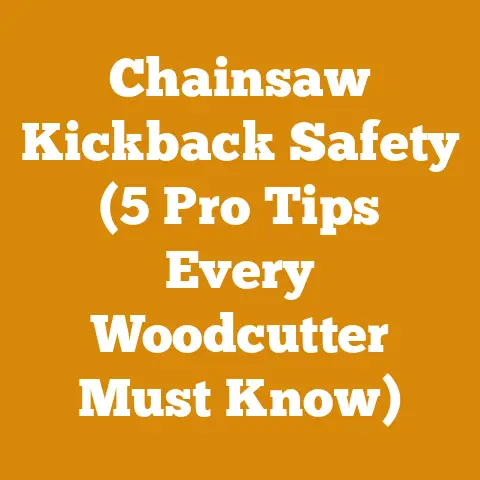Electric Wood Chippers Not Made in China (7 Pro Tips)
Ah, the scent of freshly chipped wood!
It takes me back to my grandfather’s workshop, the rhythmic thrum of his old machinery a comforting soundtrack to my childhood.
He was a master craftsman, turning rough logs into beautiful furniture, and he instilled in me a deep respect for wood and the tools that shape it.
Back then, everything was built to last, often right here in our own community.
These days, it’s harder to find that kind of quality and locally-sourced manufacturing.
That’s why I’m passionate about helping you find electric wood chippers not made in China.
It’s about supporting ethical manufacturing, investing in durable equipment, and knowing exactly where your tools come from.
In this guide, I’ll share my pro tips for selecting an electric wood chipper that meets your needs, without compromising on quality or values.
Whether you’re a homeowner tidying up your yard or a small-scale woodworker processing branches and small logs, I’ll walk you through everything you need to know.
Electric Wood Chippers Not Made in China: 7 Pro Tips
The market is flooded with options, and navigating the world of electric wood chippers can be overwhelming.
Many are manufactured in China, which may raise concerns about quality, labor practices, and long-term reliability.
This guide focuses on identifying alternatives made in other countries, emphasizing quality, durability, and ethical sourcing.
1. Why Bother? Understanding the Advantages
Before diving into specific brands and models, let’s explore the benefits of choosing an electric wood chipper not made in China.
- Superior Quality and Durability: European and North American manufacturers often adhere to stricter quality control standards, resulting in more robust and longer-lasting machines.
I’ve seen firsthand how tools built with better materials and craftsmanship can withstand years of heavy use, saving you money and frustration in the long run. - Ethical Considerations: Supporting manufacturers in countries with fair labor practices aligns with ethical consumerism.
Buying products made under humane working conditions is a conscious choice that makes a difference. - Environmental Responsibility: Some manufacturers prioritize sustainable practices, such as using recycled materials or minimizing waste during production.
Look for certifications like ISO 14001 to ensure environmental compliance. - Better Customer Support and Parts Availability: Dealing with manufacturers or distributors based in your region typically means easier access to customer support, spare parts, and technical assistance.
I’ve been burned before by trying to source obscure parts for a machine made overseas, and it’s a headache you want to avoid. - Supporting Local Economies: Purchasing from domestic or European manufacturers stimulates local economies and creates jobs in your community.
It’s a way to invest in the future of your region.
Choosing an electric wood chipper not made in China is an investment in quality, ethics, and sustainability.
It’s a decision that benefits you, the environment, and the global community.
2. Identifying Non-Chinese Electric Wood Chippers: The Research Process
Finding electric wood chippers not made in China requires diligent research.
Here’s my step-by-step approach:
- Manufacturer’s Website: Start with the manufacturer’s website.
Look for information about their production facilities, headquarters, and country of origin.
Many companies proudly display “Made in [Country]” on their websites or product pages.
If it’s not clear, dig deeper. - Product Labels and Packaging: Examine product labels and packaging for country of origin information.
Look for phrases like “Made in Germany,” “Assembled in the USA,” or “Designed in Sweden.” Be wary of vague statements like “Designed in [Country]” without specifying where the product is manufactured. - Contacting the Manufacturer: If you’re unsure about the country of origin, contact the manufacturer directly.
Ask them where the product is manufactured and what percentage of its components are sourced from outside China.
A reputable company will be transparent about its manufacturing processes. - Online Forums and Reviews: Search online forums and review websites for information about the manufacturing origins of specific models.
Other users may have already done the research and can provide valuable insights. - Retailer Information: Check the retailer’s website or product listings for country of origin information.
Some retailers provide detailed specifications, including manufacturing location. - Import Data: For the truly dedicated, import data can reveal the origin of products.
Websites like ImportGenius or Panjiva track import and export shipments, allowing you to see where specific products are being shipped from.
This is advanced research, but it can be useful for verifying claims.
Examples of Brands to Investigate (Note: Always Verify Current Manufacturing Location):
- Bosch (Germany): While some Bosch products are made in China, they also have manufacturing facilities in Europe.
Check the specific model you’re interested in. - Eliet (Belgium): Known for their high-quality garden machinery, including wood chippers.
- AS-Motor (Germany): Specializes in professional-grade lawn and garden equipment.
- Al-Ko (Germany/Austria): Offers a range of garden tools, including electric wood chippers.
- Bear Cat (USA): Focuses on heavier-duty wood chippers and shredders, often used by professionals.
- DR Power Equipment (USA): Known for their chipper shredders and other outdoor power equipment.
Important Note: Manufacturing locations can change.
Always verify the country of origin of the specific model you’re interested in before making a purchase.
Don’t rely solely on brand reputation.
3. Key Features to Consider: Power, Capacity, and Cutting Mechanism
Choosing the right electric wood chipper depends on your specific needs and the types of materials you’ll be processing.
Here are the key features to consider:
- Motor Power: Electric wood chippers are typically rated in horsepower (HP) or amperage (amps).
Higher horsepower or amperage indicates greater power and the ability to chip larger branches.- Light-duty (1-2 HP/7-10 amps): Suitable for small branches, leaves, and garden debris.
Ideal for homeowners with small yards. - Medium-duty (2-3 HP/10-15 amps): Can handle branches up to 2-3 inches in diameter.
Suitable for larger yards and occasional use. - Heavy-duty (3+ HP/15+ amps): Capable of chipping branches up to 3-4 inches in diameter.
Ideal for professional use or homeowners with large properties and frequent chipping needs.
- Light-duty (1-2 HP/7-10 amps): Suitable for small branches, leaves, and garden debris.
- Chipping Capacity: This refers to the maximum diameter of branches the chipper can handle.
Choose a chipper with a capacity that matches the size of branches you typically need to process.
Don’t overestimate – consistently feeding branches that are too large will damage the machine. - Cutting Mechanism: Electric wood chippers use different cutting mechanisms to chip branches:
- Blade Chipper: Uses one or more rotating blades to chop branches into small pieces.
These are typically more affordable and suitable for lighter-duty tasks.
Blade sharpness is crucial for efficient chipping.
Dull blades can lead to jamming and reduced performance.
I recommend sharpening the blades regularly, using a fine-grit sharpening stone and following the manufacturer’s instructions. - Impeller Chipper: Uses a rotating impeller with multiple blades to shred branches.
These are more powerful and can handle thicker branches than blade chippers.
Impeller chippers tend to be more expensive but offer better performance and durability. - Hammer Mill Chipper: Uses a series of hammers to pulverize branches and leaves into a fine mulch.
These are ideal for processing large volumes of organic material and creating compost.
Hammer mill chippers are generally the most expensive and require more maintenance.
- Blade Chipper: Uses one or more rotating blades to chop branches into small pieces.
- Hopper Size and Design: The hopper is the opening where you feed branches into the chipper.
A larger hopper can accommodate bulkier branches, while a wider hopper makes it easier to feed branches with multiple stems.
Consider the height and angle of the hopper for comfortable and efficient feeding. - Collection Bag or Discharge Chute: Electric wood chippers typically come with a collection bag or a discharge chute.
Collection bags are convenient for collecting and disposing of chips, while discharge chutes allow you to direct the chips into a pile or container.
Consider the capacity of the collection bag and the adjustability of the discharge chute. - Safety Features: Safety is paramount when operating any power equipment.
Look for chippers with the following safety features:- Overload Protection: Prevents the motor from overheating and damage.
- Safety Interlock: Prevents the chipper from operating if the hopper or collection bag is not properly installed.
- Push Stick or Plunger: Allows you to safely feed branches into the chipper without putting your hands near the blades.
- Emergency Stop Switch: Immediately stops the chipper in case of an emergency.
- Portability: If you need to move the chipper around your yard, consider a model with wheels and a handle.
Some chippers are also foldable for compact storage.
My Experience: I’ve used both blade chippers and impeller chippers.
For general yard cleanup and processing small branches, a blade chipper is sufficient.
However, for larger branches and tougher materials, an impeller chipper is the way to go.
I once tried to chip a pile of wet, stringy cedar branches with a blade chipper, and it was a complete disaster.
The blades kept getting clogged, and the motor struggled to keep up.
Lesson learned: choose the right tool for the job!
4. Understanding Voltage and Power Requirements
Electric wood chippers require a specific voltage and amperage to operate properly.
Before purchasing a chipper, make sure your electrical system can handle its power requirements.
- Voltage: Most electric wood chippers operate on standard household voltage (120V in North America, 220-240V in Europe and other regions).
However, some larger models may require 240V.
Check the chipper’s specifications to determine its voltage requirements. - Amperage: The amperage rating indicates the amount of current the chipper draws.
Make sure your circuit breaker or fuse can handle the chipper’s amperage draw.
Overloading a circuit can trip the breaker or blow a fuse, and it can also be a fire hazard. - Extension Cords: If you need to use an extension cord, choose a heavy-duty cord with the appropriate gauge for the chipper’s amperage draw.
A thin or lightweight extension cord can cause voltage drop, which can damage the motor.
I recommend using a 12-gauge or 10-gauge extension cord for most electric wood chippers. - Dedicated Circuit: For larger electric wood chippers, consider using a dedicated circuit to avoid overloading other appliances on the same circuit.
A dedicated circuit provides a stable and reliable power supply.
Example: Let’s say you’re considering an electric wood chipper that requires 15 amps at 120V.
Before plugging it in, check your circuit breaker to make sure it’s rated for at least 15 amps.
If you’re using an extension cord, make sure it’s a heavy-duty 12-gauge cord.
If you’re running other appliances on the same circuit, consider using a dedicated circuit to avoid overloading the system.
5. Material Matters: Choosing the Right Wood for Chipping
Not all wood is created equal.
The type of wood you’re chipping can affect the chipper’s performance and the quality of the chips.
- Green Wood vs.
Seasoned Wood: Green wood is freshly cut wood that still contains a high moisture content.
Seasoned wood has been dried for several months or years, reducing its moisture content.- Green Wood: Easier to chip than seasoned wood because it’s softer and more pliable.
However, green wood chips tend to be wetter and heavier, and they may decompose more quickly. - Seasoned Wood: Harder to chip than green wood, but it produces drier and lighter chips that are ideal for mulching or landscaping.
Seasoned wood chips also last longer and resist decomposition.
- Green Wood: Easier to chip than seasoned wood because it’s softer and more pliable.
- Hardwood vs.
Softwood: Hardwoods are generally denser and more difficult to chip than softwoods.- Hardwoods: Oak, maple, birch, and ash are examples of hardwoods.
These woods produce durable chips that are ideal for high-traffic areas. - Softwoods: Pine, fir, spruce, and cedar are examples of softwoods.
These woods are easier to chip but produce softer chips that may break down more quickly.
- Hardwoods: Oak, maple, birch, and ash are examples of hardwoods.
- Wood with Knots and Branches: Wood with knots and branches can be difficult to chip because they can jam the chipper or damage the blades.
Remove as many knots and branches as possible before feeding the wood into the chipper. - Wood with Nails or Metal: Never chip wood that contains nails, screws, or other metal objects.
These objects can damage the chipper’s blades and pose a safety hazard. - Treated Wood: Avoid chipping treated wood, such as pressure-treated lumber or painted wood.
Treated wood contains chemicals that can be harmful to the environment and your health.
My Tip: I often chip a mixture of green and seasoned wood to achieve the desired moisture content and chip quality.
For example, if I’m making mulch for my garden, I’ll mix green wood chips with seasoned wood chips to create a balanced product that decomposes slowly and provides nutrients to the soil.
6. Maintenance and Longevity: Keeping Your Chipper Running Smoothly
Proper maintenance is essential for extending the life of your electric wood chipper and ensuring optimal performance.
- Cleaning: After each use, clean the chipper thoroughly to remove debris, sap, and wood chips.
Use a brush or compressed air to clean the hopper, blades, and discharge chute. - Blade Sharpening: Sharp blades are crucial for efficient chipping.
Sharpen the blades regularly, using a fine-grit sharpening stone and following the manufacturer’s instructions.
Dull blades can cause the motor to strain and overheat. - Lubrication: Lubricate moving parts regularly, such as the bearings and gears.
Use a high-quality lubricant recommended by the manufacturer. - Belt Tension: Check the belt tension regularly and adjust as needed.
A loose belt can cause the motor to slip, while a tight belt can put excessive strain on the bearings. - Storage: Store the chipper in a dry, sheltered location to protect it from the elements.
Cover the chipper with a tarp or plastic sheet to prevent dust and moisture from accumulating. - Regular Inspections: Inspect the chipper regularly for signs of wear and tear, such as cracks, loose bolts, or damaged cords.
Repair or replace any damaged parts immediately. - Following the Manual: Always follow the manufacturer’s instructions for maintenance and operation.
The manual provides valuable information about troubleshooting, safety precautions, and recommended maintenance schedules.
My Case Study: I once neglected to clean my electric wood chipper after using it to chip a pile of pine branches.
The sap hardened on the blades and in the discharge chute, causing the chipper to jam and overheat the next time I used it.
It took me hours to clean the chipper and restore it to proper working order.
Lesson learned: regular cleaning is essential!
7. Safety First: Operating Your Electric Wood Chipper Responsibly
Operating an electric wood chipper can be dangerous if proper safety precautions are not followed.
Always prioritize safety when using this powerful equipment.
- Read the Manual: Before operating the chipper, read the manufacturer’s manual thoroughly and understand all safety instructions and warnings.
- Wear Protective Gear: Always wear appropriate protective gear, including:
- Safety Glasses: To protect your eyes from flying debris.
- Hearing Protection: To protect your ears from the loud noise of the chipper.
- Gloves: To protect your hands from splinters and cuts.
- Long Sleeves and Pants: To protect your skin from scratches and abrasions.
- Sturdy Shoes: To provide good traction and protect your feet.
- Clear the Area: Before starting the chipper, clear the area of any obstacles, such as rocks, branches, or toys.
Keep children and pets away from the chipper at all times. - Use a Push Stick: Always use a push stick or plunger to feed branches into the chipper.
Never put your hands near the blades. - Feed Branches Slowly: Feed branches into the chipper slowly and steadily.
Do not force branches into the chipper. - Avoid Loose Clothing: Avoid wearing loose clothing, jewelry, or long hair that could get caught in the chipper.
- Stay Alert: Pay attention to what you’re doing and stay alert while operating the chipper.
Do not operate the chipper if you’re tired, distracted, or under the influence of drugs or alcohol. - Never Modify: Never modify the chipper in any way.
Modifying the chipper can compromise its safety and void the warranty. - Unplug Before Maintenance: Always unplug the chipper before performing any maintenance or repairs.
- Be Aware of Kickback: Be aware of the potential for kickback, which can occur when a branch is suddenly ejected from the chipper.
Stand to the side of the chipper while feeding branches to avoid being struck by kickback.
My Personal Rule: I always take a few minutes before starting any wood chipping project to review the safety instructions in the manual.
It’s a simple habit that can prevent accidents and keep you safe.
I also make sure my family knows I’m operating the chipper and that they should stay clear of the area.
By following these safety tips, you can operate your electric wood chipper responsibly and avoid accidents.
Remember, safety is always the top priority.
Next Steps: Implementing Your Knowledge
Now that you’re armed with the knowledge to choose an electric wood chipper not made in China, it’s time to put your research skills to the test.
Start by identifying a few brands that align with your needs and values.
Visit their websites, read reviews, and contact them directly to verify the country of origin.
Don’t be afraid to ask questions and demand transparency.
Once you’ve narrowed down your options, compare the features, specifications, and prices of different models.
Consider your budget, the types of materials you’ll be processing, and the amount of space you have for storage.
Finally, invest in a high-quality electric wood chipper that will provide years of reliable service.
Remember, choosing a chipper not made in China is an investment in quality, ethics, and sustainability.
It’s a decision that you can feel good about for years to come.
And remember, the scent of freshly chipped wood is a reward for a job well done, a connection to nature, and a reminder of the value of sustainable practices.
Happy chipping!






